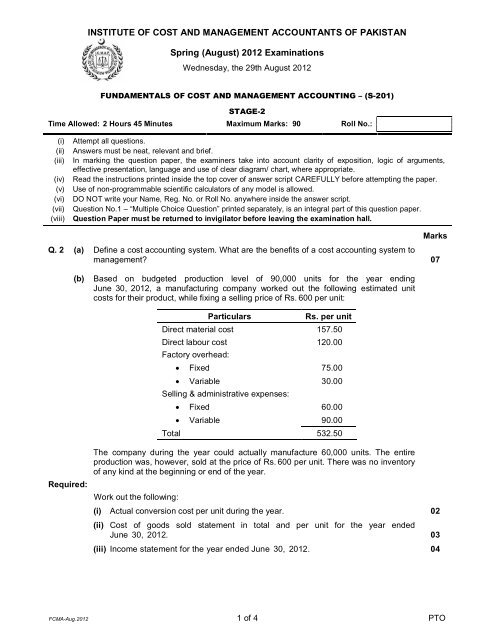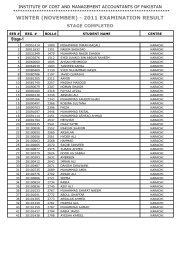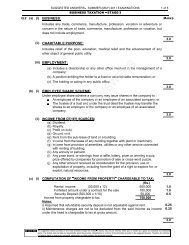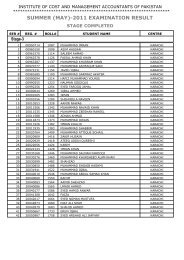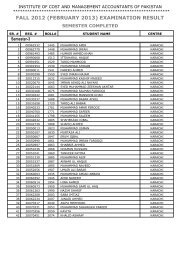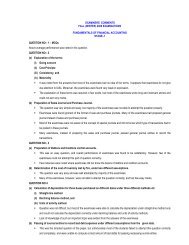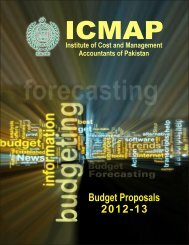(August) 2012 Examinations - Institute of Cost and Management ...
(August) 2012 Examinations - Institute of Cost and Management ...
(August) 2012 Examinations - Institute of Cost and Management ...
Create successful ePaper yourself
Turn your PDF publications into a flip-book with our unique Google optimized e-Paper software.
INSTITUTE OF COST AND MANAGEMENT ACCOUNTANTS OF PAKISTAN<br />
Spring (<strong>August</strong>) <strong>2012</strong> <strong>Examinations</strong><br />
Wednesday, the 29th <strong>August</strong> <strong>2012</strong><br />
FUNDAMENTALS OF COST AND MANAGEMENT ACCOUNTING – (S-201)<br />
STAGE-2<br />
Time Allowed: 2 Hours 45 Minutes Maximum Marks: 90 Roll No.:<br />
(i)<br />
(ii)<br />
(iii)<br />
(iv)<br />
(v)<br />
(vi)<br />
(vii)<br />
(viii)<br />
Attempt all questions.<br />
Answers must be neat, relevant <strong>and</strong> brief.<br />
In marking the question paper, the examiners take into account clarity <strong>of</strong> exposition, logic <strong>of</strong> arguments,<br />
effective presentation, language <strong>and</strong> use <strong>of</strong> clear diagram/ chart, where appropriate.<br />
Read the instructions printed inside the top cover <strong>of</strong> answer script CAREFULLY before attempting the paper.<br />
Use <strong>of</strong> non-programmable scientific calculators <strong>of</strong> any model is allowed.<br />
DO NOT write your Name, Reg. No. or Roll No. anywhere inside the answer script.<br />
Question No.1 – “Multiple Choice Question” printed separately, is an integral part <strong>of</strong> this question paper.<br />
Question Paper must be returned to invigilator before leaving the examination hall.<br />
Q. 2 (a) Define a cost accounting system. What are the benefits <strong>of</strong> a cost accounting system to<br />
management? 07<br />
Marks<br />
(b)<br />
Based on budgeted production level <strong>of</strong> 90,000 units for the year ending<br />
June 30, <strong>2012</strong>, a manufacturing company worked out the following estimated unit<br />
costs for their product, while fixing a selling price <strong>of</strong> Rs. 600 per unit:<br />
Particulars<br />
Rs. per unit<br />
Direct material cost 157.50<br />
Direct labour cost 120.00<br />
Factory overhead:<br />
Fixed 75.00<br />
Variable 30.00<br />
Selling & administrative expenses:<br />
Fixed 60.00<br />
Variable 90.00<br />
Total 532.50<br />
Required:<br />
The company during the year could actually manufacture 60,000 units. The entire<br />
production was, however, sold at the price <strong>of</strong> Rs. 600 per unit. There was no inventory<br />
<strong>of</strong> any kind at the beginning or end <strong>of</strong> the year.<br />
Work out the following:<br />
(i) Actual conversion cost per unit during the year. 02<br />
(ii) <strong>Cost</strong> <strong>of</strong> goods sold statement in total <strong>and</strong> per unit for the year ended<br />
June 30, <strong>2012</strong>. 03<br />
(iii) Income statement for the year ended June 30, <strong>2012</strong>. 04<br />
FCMA-Aug.<strong>2012</strong> 1 <strong>of</strong> 4 PTO
Marks<br />
Q. 3 (a) The following information is available for valuation <strong>of</strong> inventory as on June 30:<br />
June<br />
1 Beginning balance 800 units @ Rs. 15/unit<br />
4 Purchased 200 units @ Rs. 18/unit<br />
7 Purchased 200 units @ Rs. 20/unit<br />
18 Issued 400 units<br />
25 Purchased 300 units @ Rs. 21/unit<br />
28 Issued 500 units<br />
Required:<br />
(b)<br />
Calculate the cost <strong>of</strong> materials used <strong>and</strong> the value assigned to the June 30 inventory<br />
by each <strong>of</strong> the following perpetual inventory costing methods:<br />
(i) First-in, first-out (FIFO). 06<br />
(ii) Last-in, first-out (LIFO). 04<br />
The employees’ record <strong>of</strong> a company for the week ended July 31 shows the following<br />
details <strong>of</strong> its four (4) employees:<br />
Employee<br />
Clock<br />
No.<br />
Job<br />
No.<br />
Hours<br />
Worked<br />
Production<br />
Pieces<br />
Hourly Rate<br />
(Rs.)<br />
Piece Rate<br />
(Rs.)<br />
Arshad 15 79 40 960 – 3.00<br />
Badar 16 – 46 – 70.00 –<br />
Chohan 17 74 40 – 58.00 –<br />
Danish 18 – 40 – 72.00 –<br />
The company operates 40 hours per week <strong>and</strong> pays 50% in addition to normal rates<br />
for overtime. Additional information is as under:<br />
(i)<br />
Badar works in the storeroom issuing materials. Danish is the supervisor, <strong>and</strong><br />
others worked directly on special orders as noted.<br />
(ii) Deduction @ 6.5% would be made for each employee on account <strong>of</strong> employees<br />
children education fund.<br />
(iii) An advance against salary <strong>of</strong> Rs. 1,000 was made to Arshad on July 26.<br />
(iv) A 2% deduction is to be made from each employee’s wage for the company’s<br />
employee health <strong>and</strong> hospital benefit plan.<br />
(v) Income tax @ 10% is deducted at source.<br />
Required:<br />
Prepare the payroll sheet for the week showing each employee’s <strong>and</strong> total<br />
(<strong>of</strong> 4 employees) gross pay, deductions, <strong>and</strong> net pay. 10<br />
Q. 4 (a) Khair Company’s factory overhead rate is Rs. 30 per hour. Budgeted overhead for<br />
3,000 hours per month is Rs. 160,000 <strong>and</strong> at 7,000 hours is Rs. 240,000. Actual factory<br />
overhead for the month is Rs. 180,000, <strong>and</strong> actual hours worked are 5,000.<br />
Required:<br />
Calculate the following:<br />
(i) Variable overhead rate (portion) in overhead rate. 02<br />
(ii) Budgeted fixed overhead. 02<br />
(iii) Normal volume or normal capacity hours. 04<br />
(iv) Applied factory overhead. 02<br />
FCMA-Aug.<strong>2012</strong> 2 <strong>of</strong> 4
(b)<br />
A manufacturing company produces a product in its three producing departments. The<br />
following quantitative data has been made available:<br />
Production Data (kgs):<br />
Department<br />
A B C<br />
Started into production 20,000 13,500 8,000<br />
Transferred to next department 13,500 8,000<br />
Transferred to finished goods storeroom 5,250<br />
In process (100% materials, 1 / 3 labour <strong>and</strong> overhead) 6,000 4,500<br />
In process (100% materials, 2 / 3 labour <strong>and</strong> overhead) 2,250<br />
Marks<br />
Required:<br />
Lost units are normal <strong>and</strong> apply to all production.<br />
Workout the following for each <strong>of</strong> the three departments:<br />
(i) A quantity schedule. 06<br />
(ii) An equivalent production schedule. 06<br />
Q. 5 (a) Following information is related to the cost <strong>of</strong> a job:<br />
Materials<br />
Labour<br />
Qty Rs./ unit Hours Rs./ hour<br />
50 20 20.00 40<br />
55 24 10.00 44<br />
60 22 15.00 36<br />
54 18 22.50 32<br />
55 16 20.00 30<br />
Required:<br />
(b)<br />
Factory overhead is Rs. 36 per labour hour, marketing expense is 25% <strong>and</strong><br />
administrative expense is 20% <strong>of</strong> total factory cost. Margin is 50% <strong>of</strong> total cost.<br />
Prepare a Job Order <strong>Cost</strong> Sheet showing clearly the followings:<br />
(i) total factory cost. 06<br />
(ii) total marketing <strong>and</strong> administrative expenses. 01<br />
(iii) pr<strong>of</strong>it margin. 01<br />
(iv) sales amount. 01<br />
What is st<strong>and</strong>ard cost card? Prepare a specimen st<strong>and</strong>ard cost card putting imaginary<br />
figures. 07<br />
FCMA-Aug.<strong>2012</strong> 3 <strong>of</strong> 4 PTO
Q. 6 (a) Following data is collected from the records <strong>of</strong> Beta Company Limited for a month in<br />
respect <strong>of</strong> manufacturing a product Gamma. Two (2) units <strong>of</strong> material used <strong>and</strong> the<br />
predetermined purchase price for material is Rs. 60 per unit. Labour required to<br />
produce one (1) unit is 4 hours <strong>and</strong> the labour rate per hour is Rs. 100.<br />
The actual production for Gamma was 10,000 units <strong>and</strong> consumption <strong>of</strong> materials,<br />
labour worked <strong>and</strong> wages paid were as follows:<br />
Material used 22,000 units @ Rs. 70 per unit<br />
Labour worked 42,000 hours, were paid @ Rs. 125 per hour.<br />
Marks<br />
Required:<br />
(b)<br />
Calculate the following:<br />
(i) Materials quantity (usage) variance. 02<br />
(ii) Materials price variance. 02<br />
(iii) Labour time variance. 02<br />
(iv) Labour rate variance. 02<br />
Alpha Limited produces a product with the following cost at the current output <strong>of</strong><br />
25,000 units at selling price <strong>of</strong> Rs. 240 per unit:<br />
Particulars<br />
Production cost (variable)<br />
Selling cost (variable)<br />
Fixed cost<br />
Rs.<br />
120 per unit<br />
40 per unit<br />
750,000 per annum<br />
Required:<br />
The company is <strong>of</strong> the view that by hiring an improved machine for production, the<br />
variable cost <strong>of</strong> production would decrease to Rs. 100 per unit. The hiring cost <strong>of</strong> the<br />
machine would be Rs. 450,000.<br />
Calculate the following:<br />
(i) Breakeven point in units <strong>and</strong> rupees before <strong>and</strong> after hiring <strong>of</strong> new machine. 04<br />
(ii) The number <strong>of</strong> units that must be sold to achieve the same pr<strong>of</strong>it as being<br />
currently earned, if the new machine is hired. 04<br />
THE END<br />
FCMA-Aug.<strong>2012</strong> 4 <strong>of</strong> 4


